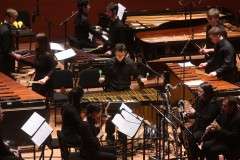|
Back
From Finland With Mastery New York
Alice Tully Hall, Lincoln Center
03/28/2013 -
Sean Shepherd: Blur
Veli-Matti Puumala: Mure
Elliott Carter: Asko Concerto
Jukka Tiens: Mood
Anthony Cheung: Dystemporal
AXIOM: Juilliard School Students and The Sibelius Academy Students, Susanna Mälkki (Guest Conductor)

S. Mälkki (© Simon Fowler)
Once upon a time, Finland’s image consisted of a Midnight Sun, 6,000,000 saunas, one composer named Jan Sibelius, mosquitos far more powerful than their Lutheran God, and the Claus Toy-Making Conglomerate, mercilessly exploiting Elf Labor every day except Christmas.
Today, they have augmented their reputations with a panoply of internationally great musicians, conductors and composers. Magnus Lindberg, Esa-Pekka Salomen, Karita Matilla, Kari Kriikku, and Einojuhani Rautavaara are among the best known names, but the Finns are springing up like Arctic wildberries s in orchestras around the world.
It was easy last night to hear why the Finnish Renaissance is so dynamic, as 14 top young musicians from Sibelius Academy (Finland’s Juilliard) with 16 top ranking musicians from Juilliard (New York’s Sibelius Academy) for an evening of modern American and Finnish music. Their conductor was another burgeoning name in Finnish music, Susanna Mälkki, her second appearance here in less than a year.
The solo players of this chamber symphony were divided equally, with the First Chair violin switching from our own Ken Hamao to their Einari Liikanen. The tuba player came from Finland, the harpist was one of ours, the keyboard was from Finland, and the saxophone–that icon of American jazz–was from the Sibelius Academy.
Two of the composers were present, two back in Finland, and Elliott Carter was probably offering his beatific smile from somewhere Up There for this Asko Concerto, written for a Dutch modern music ensemble when he was a young lad of 92. His secret in this work– yet to be mastered by the other four composers last night–was to take the most complex expressive, metrical and timbral sounds, with the most outrageously eccentric duets and trios and make it sound like fun.
The combos consisted of two duets (trumpet and violin, clarinet cadenza with double bass) with other strange ensembles, my favorite being piccolo, xylophone, celesta, harp and violin. Yet it was difficult to say they played together. They all played with different rhythms, different keys, with themes that were totally separate–and yet Mr. Carter managed to make this musical Tower of Babel into a circus of clever sounds. The everlasting greatness of Mr. Carter was that he never disguised his complex technique, but that only makes the piece more attractive. Like a great magician, he may explain his magic, but you are still inescapably mesmerized by the effects.
If only Anthony Cheung could have done this–and hopefully this young highly praised composer will. His Dystemporal, he writes, is about “the disorienting and distorted way in which time is manipulated and perceived.” Well, yes. We could spot the circles and canons, and the equations going round and round. Mr. Cheung is an extraordinarily gifted composer. And it would be doing him an injustice to say he is “cerebral”, for he is not cold. But this was austere music, brilliantly put together but somehow lacking in focus, devoid of (for lack of a better word), an attitude.
The third American composer, Sean Shepherd, was also tackling the problem of time and space (us Yankees never think humble), this time with a jauntier tone. The genesis was train or car trip, and the Blur of sights seen through the window. The work was sui generis rapid, with images piling onto each other, repeating, retrograding in memory or accelerating. The orchestral colors were bright, the soloists playing with utmost precision.
Ms. Mälkki needs no baton to make her points. As Musical Director of the “Ensemble intercontemporain”, she is a prime mover of modern music, and her rapport with the AXIOM orchestra last night was obvious.

Axiom Ensemble (© Hiroyuki Ito)
Still, it was astonishing to see how she conducted the crazy and eerily beautiful Mood Stereophonic Music by Helsinki-born Jukka Tiens, who, at 64, writes with the snappy steps of a young Arctic reindeer. The chamber orchestra was divided in half across the stage, Ms. Mälkki moderating the two groups. Not that they were in conflict. Instead, this short delightful work had a thousand fragments, all based on a few intervals, uttered on one side, echoed with a different instrument on the other, played again with both, playing harp against horn, oboe against bassoon, tuba against double bass. It was antic, pyrotechnical and short enough never to outlast its welcome.
The most mysterious work was certainly Mure by Veli-Matti Puumala, written during Midnight Sun time but exploring the 24-hour darkness of the Finnish winter. The word “Mure” isn’t in my old Finnish-English dictionary but it is apparently an ancient word for grief or sorrow. Mure itself had two distinct sections, the first rolling steadily with the small orchestra playing the most brilliant sounds, accentuated by percussionist Virva Kuusi banging on the largest bass drum I’ve ever seen, with marimba, gongs and a few other instruments. But this was no orchestral tour de force. Suddenly the music turned down. It was sour, dour, almost exclusively winds in the lowest depths, including a bass flute.
This was a sudden change, not a welcome change, but Mr. Puumala knew what he wanted to project. The music was dense, stolid, alien. When in Finland once, I saw an advertisement for a series of lectures about the “psychological and artistic effects of the 24-hour winter” Mr. Puumala didn’t need a lecture. He captured the gloom perhaps too well, an impenetrable darkness in this otherwise beatific country.
Harry Rolnick
|